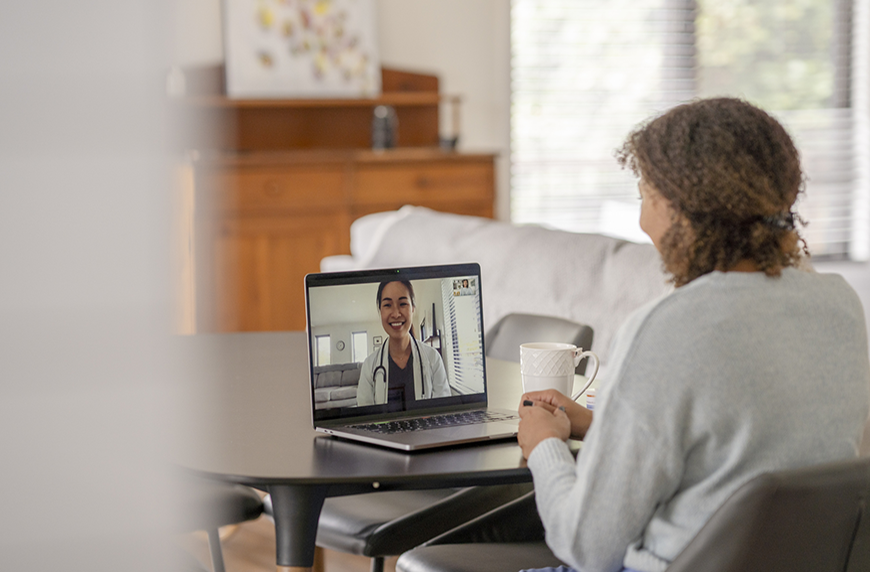
With more investment in technology and infrastructure to support the delivery of telemedicine, consumer demand for telehealth services is growing. While some early models have stumbled, more sustainable models are gaining ground. In this article, we review the shifting telehealth landscape and explain how virtual care is transforming care delivery today.
A consumer-centric approach to telehealth
At one point during the pandemic, nearly half of all healthcare visits happened virtually, according to Matt Brown, vice president of telehealth at CHG Healthcare Services. “This broad exposure to telemedicine gave patients the first flavor of what it could look like to engage virtually with their providers,” he says.
Consumers now want options — they want to see their provider in person when necessary but still have access to virtual visits when it makes sense. “Patients have started to take a more consumer-centric approach to how they want to engage in telehealth, and systems are starting to adapt their delivery mechanisms,” Brown explains. “With hybrid approaches, they’re addressing consumers in more of a multimodal fashion.”
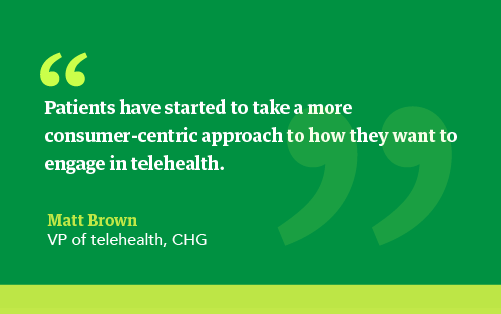
Trends in telehealth: The future of virtual care
Transitioning from telehealth 1.0 to 2.0
Early telehealth models were built for high-volume urgent care, particularly in retail settings — and those models are starting to struggle. For example, Walmart, Amazon, and Village MD have all scaled back or shuttered their telehealth offerings.
“These early retail models were designed to allow consumers to also purchase eye drops and potato chips and other things at the pharmacy,” Brown says. But telehealth hasn’t translated into that kind of consumer traffic. More importantly, this model does not engage consumers in a continuing care relationship.
“The combination of those two things created the perfect storm for some of these retailers to say, ‘This is much more complex and much more nuanced, and the delivery of this healthcare is way more difficult than we had expected,’” Brown continues.
He says this pullback of “telehealth 1.0” has caused some concern about telehealth’s overall viability, but models are simply shifting — they’re realigning around specialty care embedded into a continuum of care.
“We're moving into telehealth 2.0,” he says. “This phase involves moving patients from that first digital doorstep into longer-term, longitudinal, specialty care.” And health systems are prepared for that transition. Their build-out of telehealth infrastructure has been slower and more deliberate than the retail providers, leaving them with a full continuum of care that can manage complex conditions and foster long-term patient relationships.
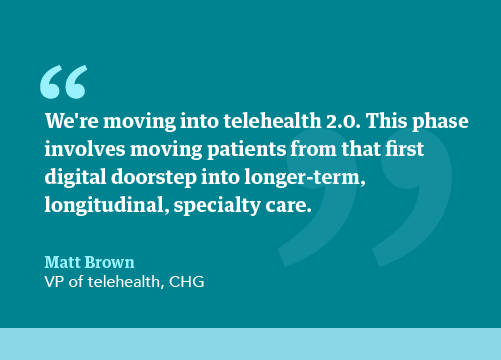
The provider approach to virtual care
Providers play a significant role in the future of telehealth. Overall, physicians want to be part of a care delivery system rather than working for “a retailer that thinks of it as a means to an end financially,” Brown says.
However, providers have had to adapt their approaches to engaging with patients; they are figuring out which visits can be virtual and how to best communicate with patients. “So, it's become even more complex from the provider side,” he says.
Despite the complexity, providers are optimistic about the new potential for flexibility.
“What we're hearing and seeing from our members is quite a lot of physicians are starting to ask for more flexibility, whether that means doing more telehealth appointments or some type of flexible scheduling,” says Liz Mahan, director of professional development and solutions for AAPPR.
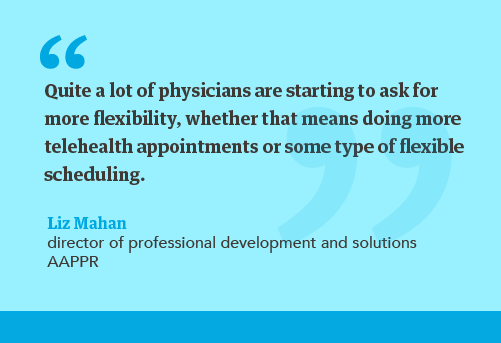
Even small concessions to flexibility make a big difference for providers. “When we see the option for even a single virtual day a week come up with our health system customers, we see a spike in applicants for those jobs, and it actually opens up a new set of applicants and providers,” Brown says. Additionally, providers seem more willing to negotiate pay when the schedule is flexible.
Key questions to ask about the future of telehealth
Expanding telehealth into specialty care raises three key questions. First, will virtual models support greater patient access to specialty care? Second, will the utilization of virtual specialty care lead to better outcomes? And third, what is the actual cost of these new telehealth models?
“Some of the early fears that if we give open access at the specialty level, then patients will just want to use it all the time and it's going to run up utilization and cost, that's not playing out in the data,” Brown says.
He says the cost picture is still a little foggy, with some commercial payers reducing their reimbursement rates but Medicare holding firm on its rates across specialties.
Patient demand may influence reimbursement and cost structures. Brown points to the example of Eli Lilly, which set up a pool of telehealth providers that patients could call and ask questions about therapies — bypassing their own primary care physicians. “Never discount the consumer pushing and driving a lot of those models,” he says.
Learn more about reimbursement: Telehealth rules and resources 2024 toolkit
Considerations for approaching telehealth
According to Brown, telehealth is still in its infancy despite recent advancements and greater consumer adoption. Technology changes rapidly, and hospitals are racing to adapt their models and strategies. In that constant cycle of change and adaptation, here are things to keep in mind:
Provider recruitment. Investment in telehealth technologies sends a strong signal to potential candidates that the organization is committed to making work processes easier. “That's compelling for a physician to hear,” Brown says. Physicians will believe that “over time, they're going to augment a lot of the work with technology so that I can focus on the work that I care about.”
That’s why Brown advises recruiters to “start talking about some of the innovation and what's attractive to providers as they're coming into your group and they're thinking about their career path.”
The provider shortage. Telehealth has the potential to address the provider shortage in several ways. It can extend physicians' reach into underserved areas and allow health systems to share the services of in-demand specialists. Additionally, workflow gains will increase provider productivity and “help our clinicians to practice at the top of their license,” Brown says.
Continuing technological innovation. Brown suggests embracing tech advances only to the extent that it makes sense for your organization. “There's a tendency for us to want to go all in or all out — or say telehealth doesn't work for us,” he says. “This is going to require a more nuanced approach with how we're integrating this into our daily lives, systems, and strategies.”
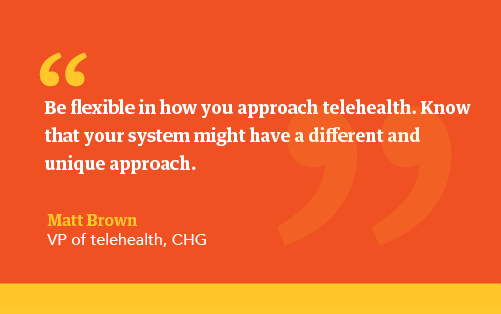
A right-sized approach. No one approach to telehealth will work for every hospital or health system — or the communities they serve. “I would advise you to be flexible in how you approach it. Know that your system might have a different and a unique approach,” Brown says.
Download "Implementing telehealth in a changing landscape: What to know" (PDF):
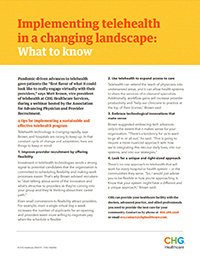
CHG can provide your healthcare facility with the doctors, nurses, and allied professionals you need to provide the best care for your community. Contact us by phone at 866.608.4020 or email at ecs.contact@chghealthcare.com.